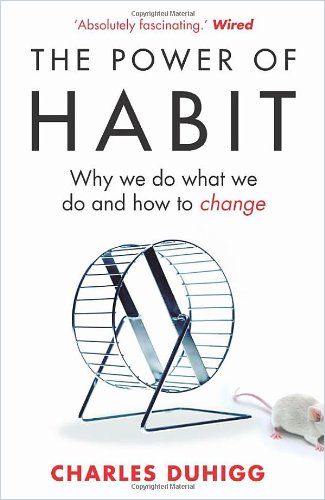Charles Duhigg analyzes how your brain forms habits, how companies also form habits, and how people and organizations can choose new, more healthful behaviors.

You Can Change
Ever wonder why some people adopt a healthier lifestyle or realize professional achievement, while others flail and fail? Author Charles Duhigg attributes this to habit and explains that successful people learn to control and change their habits.
First, he says, they understand how the three steps of the “habit loop” – “cue, routine and reward” – determine what people do without thinking. He contends that if you analyze how undesirable habits such as overeating, excess drinking or smoking operate in that loop by satiating cravings, you will be better equipped to control habits that seem to control you. Duhigg’s fun, educational book will help anyone seeking self-improvement.
This New York Times bestseller garnered inclusion in The Wall Street Journal and Financial Times’ lists of Best Books of the Year. The New York Times Book Review called it, “Entertaining…enjoyable…fascinating…a serious look at the science of habit formation and change.” The Economist said Duhigg, “provides just the right balance of intellectual seriousness with practical advice on how to break our bad habits.”
A Matter of Habit
Duhigg describes a habit as an activity you deliberately decide to perform once and continue doing without focus, often frequently. Habits develop, he explains, because the brain is wired to seek ways to conserve energy. The author describes a three-stage habit loop. First, the brain seeks a cue that will let it operate on automatic pilot and indicate what it should tell the body to do. Second, that habit becomes a routine. Its reward teaches the brain whether it should remember the loop. When the cue and reward connect, the brain develops expectations, leading to craving and the birth of a habit or behavior loop.
Once people learned how to believe in something, that skill started spilling over into other parts of their lives, until they started believing they could change.Charles Duhigg
Unfortunately, Duhigg relates, the brain does not judge whether the new habit is beneficial or detrimental. His theme is that you can change your destructive habits and adopt positive ones by understanding and managing the cue-routine-reward cycle. Duhigg advises focusing on cues and rewards, and altering your routine to thwart cravings and bad habits.
The brain looks forward to the reward of a habitual routine. Duhigg stresses that this process is not inevitable. You can, he insists, analyze your cravings to learn which one impels the habit. Or, he suggests, you can manipulate cravings to better ends; for example, if you value the endorphin rush of exercise, taking a morning run can become an automatic habit loop.
Given determination and belief, Duhigg teaches, people can change their habits if they examine and analyze them to unravel the understandable cues, routines and rewards.
You Can Change
Duhigg asserts changing that your habits means embracing the belief that you can change. This sense of belief, he notes, turns out to be more effective if it occurs in a group – such as an AA meeting.
The lessons AA provides demonstrate how almost any habit – even the most obstinate – can be changed. Charles Duhigg
The author argues that you can learn willpower as effectively as you can learn to play a musical instrument or speak a foreign language. When you master willpower, he cautions, you must keep it exercised and in shape, just as you would work to keep your muscles toned.
Organizational Habits
Organizations develop habits, Duhigg reveals, that help them do business or accomplish their goals. Starbucks’s rules for employees, for example, inculcate the concept of willpower. Starbucks’ workers, Duhigg learned, improve their lives and careers after they learn to harness their willpower to be cheerful no matter what their workdays hold.
Dughigg offers the example of Starbucks teaching employees willpower by focusing on situations that may weaken their self-discipline, like dealing with dissatisfied patrons. Employees practice routines for handling discontented customers until they perform them habitually.
If you focus on changing or cultivating keystone habits, you can cause widespread shifts.Charles Duhigg
Organizational habits, Duhigg underscores, keep firms functioning; without them, companies would descend into squabbling factions. He discloses that companies can also foretell and direct their patrons’ habits. He cites the way Target analyzed data from its consumers to enable its marketers to predict their behavior. Target learned, according to Duhigg, that patrons’ shopping habits changed most dramatically when they underwent a milestone in their lives, such as getting married, moving to a new residence or starting a family.
A Comforting Message
As a journalist, Duhigg demonstrates excellent habits. He writes clearly with an emphasis on readability. He offers entertaining, illustrative examples without bogging the reader down in too much detail. He provides research and credible sources to back up his assertions. And he draws helpful conclusions that take the reader through his analysis of habits and how to change them.
Duhigg offers the inspiring hope that no one needs to be a prisoner of bad habits. He describes cognitive and non-cognitive processes that suggest you are not entirely to blame for your habits, good or bad. That is a comforting message. Duhigg provides a guide to changing your habits, a compelling read about the processes of the brain, and a collection of insider stories of how businesses changed their habits and, thus, shaped their consumers’ choices.
Charles Duhigg also wrote Smarter, Faster, Better. Other helpful books on the science of habits include James Clear’s Atomic Habits; Daniel Kahnemann’s Thinking, Fast and Slow; and Richard Koch’s The 80/20 Principle.













